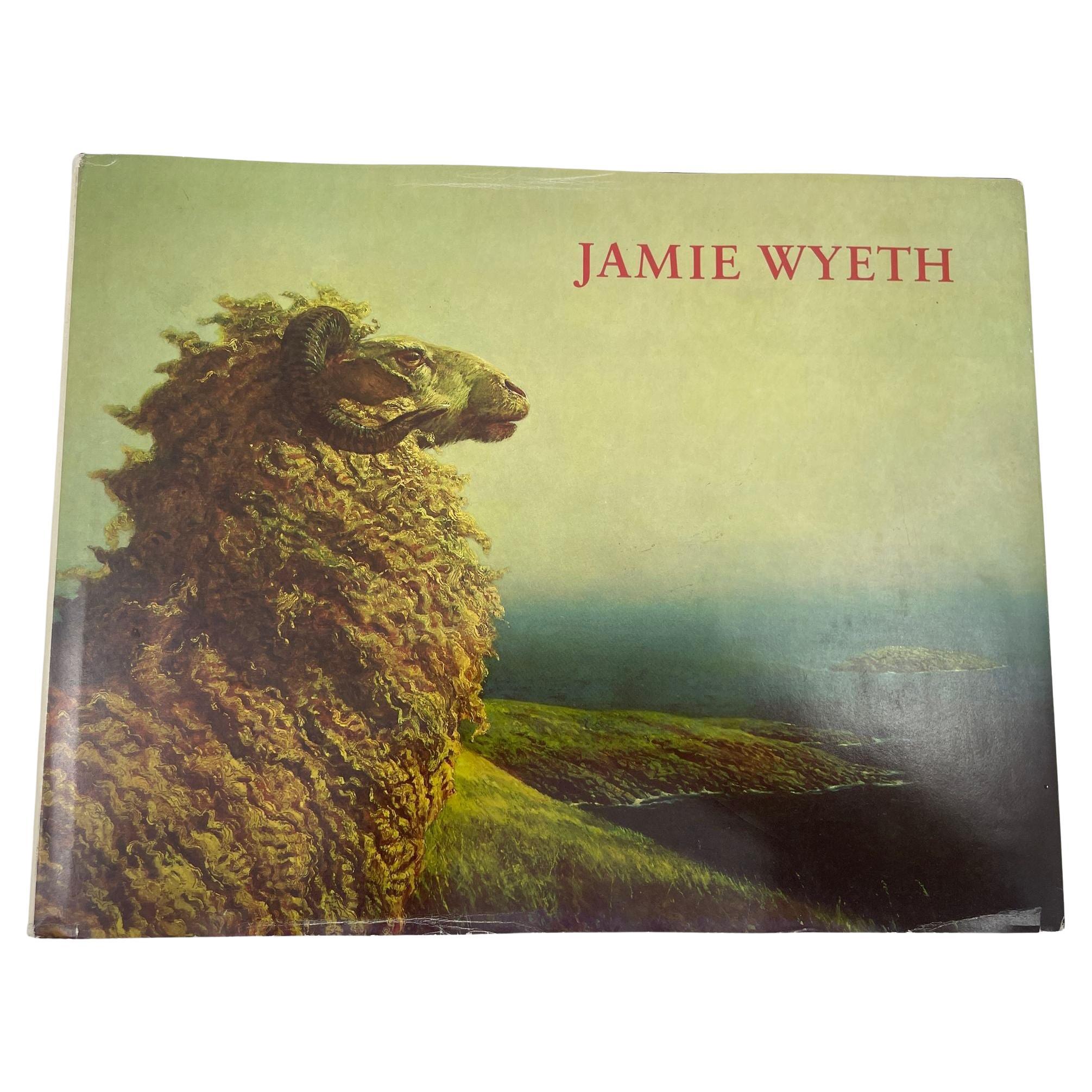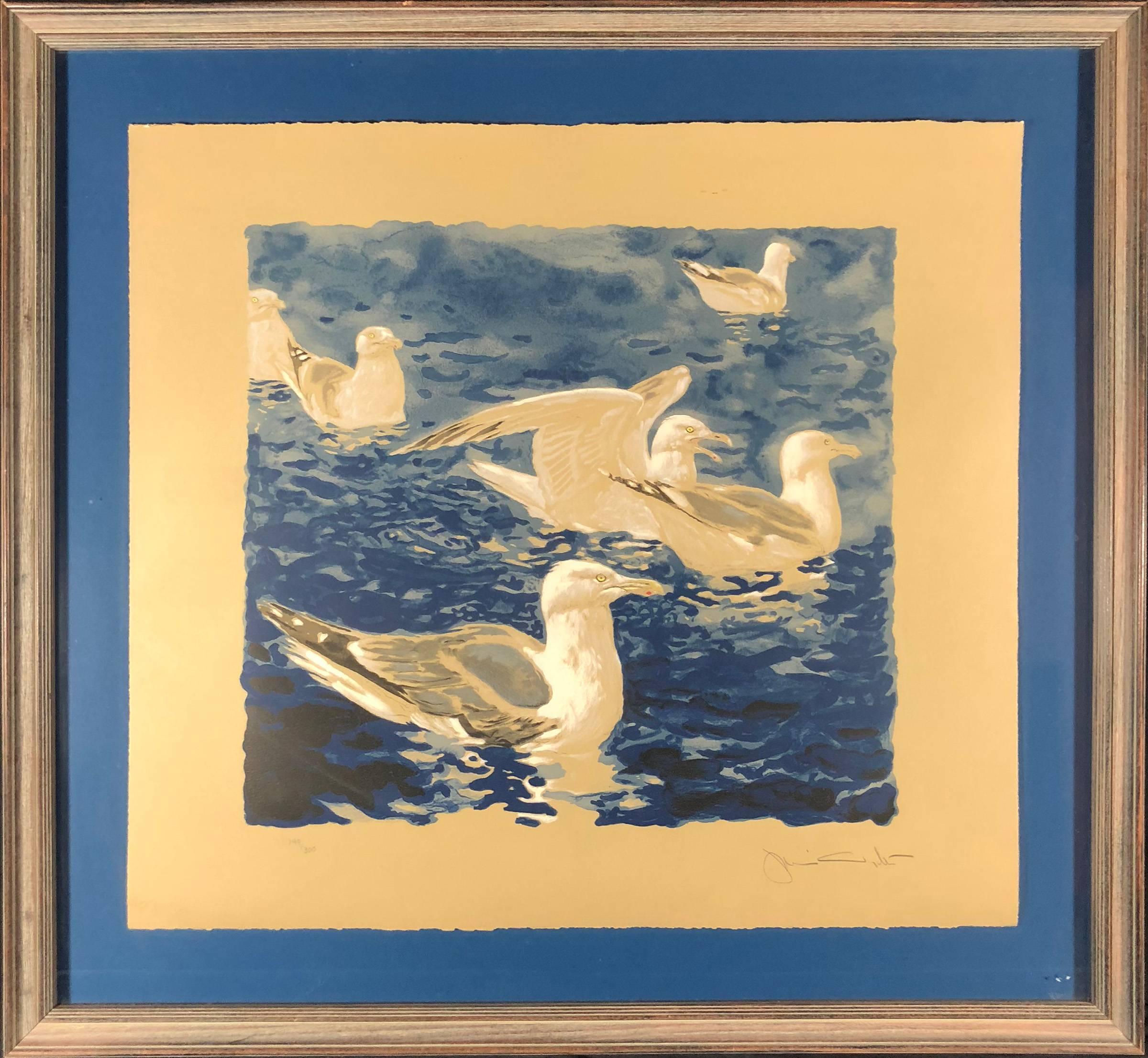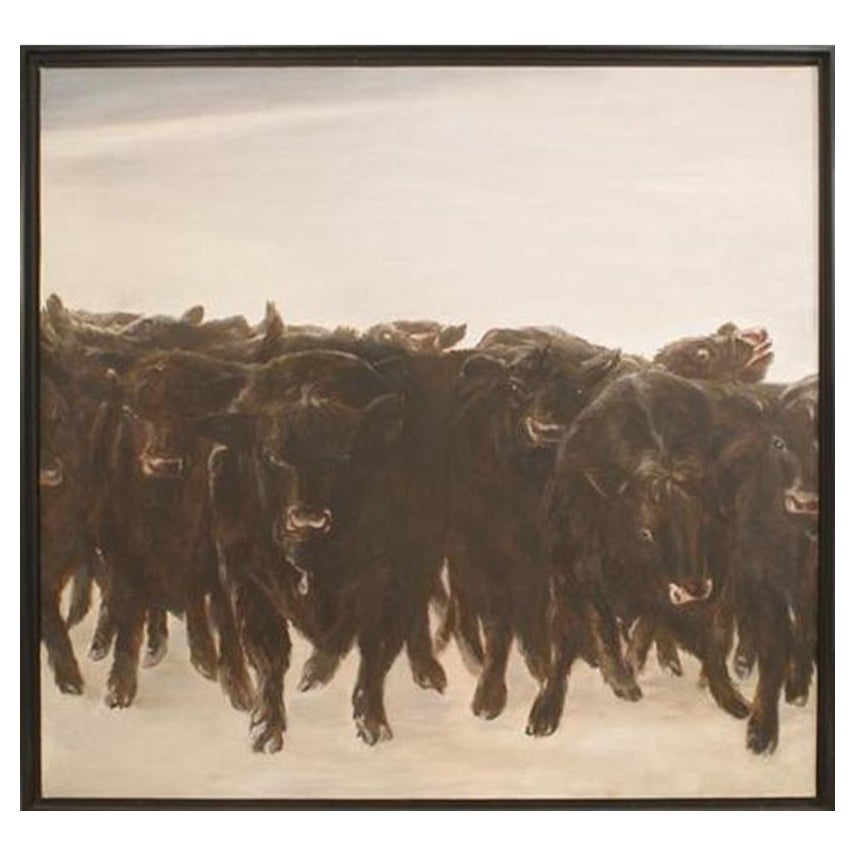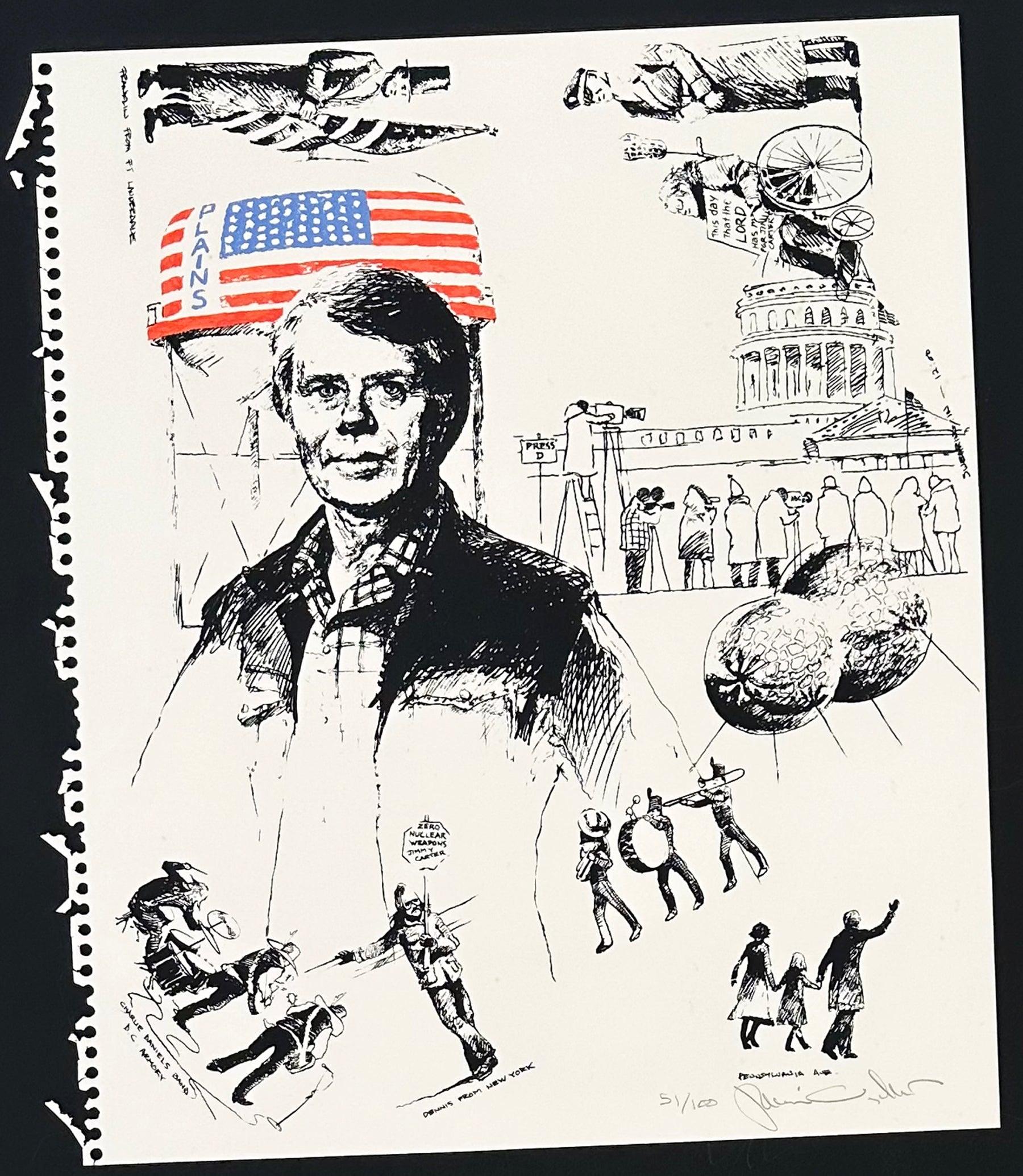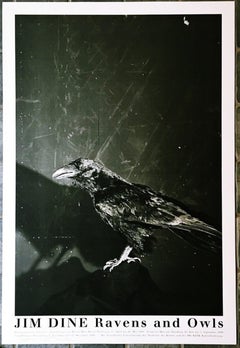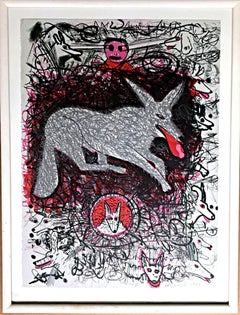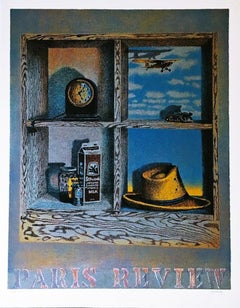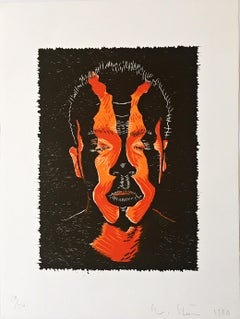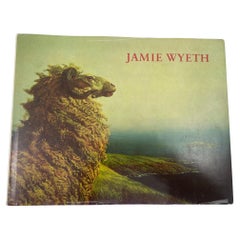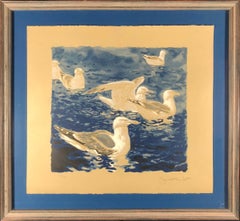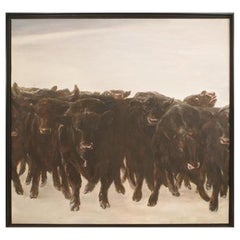Items Similar to Unsettled (hand signed and inscribed by Jamie Wyeth), offset lithograph poster
Want more images or videos?
Request additional images or videos from the seller
1 of 7
Jamie WyethUnsettled (hand signed and inscribed by Jamie Wyeth), offset lithograph poster2024
2024
$1,000
£759.52
€877.50
CA$1,401.54
A$1,568.58
CHF 818.68
MX$19,128.62
NOK 10,477.98
SEK 9,918.75
DKK 6,548.68
Shipping
Retrieving quote...The 1stDibs Promise:
Authenticity Guarantee,
Money-Back Guarantee,
24-Hour Cancellation
About the Item
Jamie Wyeth
Unsettled (hand signed and inscribed by Jamie Wyeth), 2024
Offset lithograph poster (signed and inscribed to Kevin in black marker)
Boldly signed and inscribed "for Kevin" on the lower front. Accompanied by documentation of the event at Rizzoli's where Jamie Wyeth signed
31 × 22 1/2 inches
Unframed, unnumbered
Offset lithograph poster
hand signed and inscribed "For Kevin" in black marker by Jamie Wyeth
Published by The Brandywine Museum of Art, PA and the Farnsworth Art Museum, ME
This poster was signed and inscribed in black marker in person by the artist for the present owner, at a special event at Rizzoli in New York City in 2024. (documentation shown)
unframed
- Creator:Jamie Wyeth (1946, American)
- Creation Year:2024
- Dimensions:Height: 31 in (78.74 cm)Width: 22.5 in (57.15 cm)
- Medium:
- Movement & Style:
- Period:
- Condition:Excellent condition. The print was photographed from a bit of an angle, but in person it's perfectly straight. .
- Gallery Location:New York, NY
- Reference Number:1stDibs: LU1745215875982
Jamie Wyeth
Wyeth is an American realist painter. He is the son of Andrew Wyeth and grandson of N.C. Wyeth. He was raised in Chadds Ford Township, Pennsylvania. Wyeth is known for capturing the essence of domestic animals, such as chickens, dogs, pigs, and horses and the texture of animal fur and feathers, the glossiness of its eye, the grass around its feet. Wyeth is also drawn to the subject of trees and has rendered compostitions of tree trunks and their tangled roots. Wyeth's works are included in many public collections, including those of the Terra Museum of American Art, National Gallery of Art, National Portrait Gallery, John F. Kennedy Library, Museum of Modern Art, Joslyn Art Museum, Farnsworth Art Museum, Delaware Art Museum, Brandywine River Museum, Morgan Library and Museum, Museum of Fine Arts, Boston, Whitney Museum of American Art and Bowdoin College Museum of Art. Wyeth is a participating lender for the United States Department of State, Art in Embassies Program.
About the Seller
5.0
Platinum Seller
Premium sellers with a 4.7+ rating and 24-hour response times
Established in 2007
1stDibs seller since 2022
441 sales on 1stDibs
Typical response time: 2 hours
- ShippingRetrieving quote...Shipping from: New York, NY
- Return Policy
Authenticity Guarantee
In the unlikely event there’s an issue with an item’s authenticity, contact us within 1 year for a full refund. DetailsMoney-Back Guarantee
If your item is not as described, is damaged in transit, or does not arrive, contact us within 7 days for a full refund. Details24-Hour Cancellation
You have a 24-hour grace period in which to reconsider your purchase, with no questions asked.Vetted Professional Sellers
Our world-class sellers must adhere to strict standards for service and quality, maintaining the integrity of our listings.Price-Match Guarantee
If you find that a seller listed the same item for a lower price elsewhere, we’ll match it.Trusted Global Delivery
Our best-in-class carrier network provides specialized shipping options worldwide, including custom delivery.More From This Seller
View AllOffset Lithograph Poster; hand signed by Jim Dine
By Jim Dine
Located in New York, NY
Jim Dine
Raven and Owls (Hand Signed), 2000
Offset Lithograph Poster; hand signed by Jim Dine
38 3/4 × 35 1/2 inches
Hand signed by Jim Dine lower front
Unframed
This dramatic offset...
Category
Early 2000s Pop Art Animal Prints
Materials
Offset
Roy De Forest, Dog lithograph, signed/n by world renowned California pet painter
By Roy De Forest
Located in New York, NY
Roy De Forest
Untitled (Dog), 1981
Color lithograph with deckled edges. Floated and framed.
Pencil signed and numbered from the edition of 125
Frame Included: held in original vintage white frame
Wonderful whimsical rare 1981 lithograph by the incredibly popular and beloved Roy de Forest, famous for his paintings and prints of dogs...
Category
1980s Surrealist Animal Prints
Materials
Lithograph
Howard Kanovitz S/N lithograph by famed photorealist artist for The Paris Review
By Howard Kanovitz
Located in New York, NY
Howard Kanovitz
Paris Review, 1968
Lithograph on wove paper
33 × 26 inches
Pencil signed and numbered 9/200
Published by The Paris Review, New Y...
Category
1960s Photorealist Interior Prints
Materials
Lithograph
Scarce lithograph, from the Art Against AIDS Portfolio, signed/numbered 38/50
Located in New York, NY
William Steen
Untitled, from the Art Against AIDS Portfolio, 1988
Lithograph on paper with deckled edges
Hand signed, numbered 38/50 and dated on lower front with printer's and publisher's blindstamp.
20 1/5 × 15 inches
Unframed
Hand signed, numbered and dated on lower front with printer's and publisher's blindstamp.
This powerful limited edition lithograph by William Steen was published in 1988 as part of the Art Against Aids portfolio, numbered 38/50.
Superb provenance as it is was acquired from the original Art Against AIDS Portfolio published in Houston, Texas. This will be the first time the work will be removed from the portfolio. The late 1980s was the height of the AIDS epidemic, and this was one of many efforts by the creative community to raise funds to assist in fighting this deadly scourge that disproportionately affected the artistic community.
William Steen 1949-2008
William Steen, artist, collector, curator, and mystic, died of pancreatic cancer on December 20 in New York, where he has lived since 2001. Long time framer at the Menil Collection, the soft-spoken Steen is remembered in Houston where he had his first exhibition of paintings in 1978 at the Roberto Molina Gallery. In 1984 Steen made his first of several trips to India, photographing thousands of Tibetan Buddhist ritual paintings. A champion of outsider art, in 2000 he tangled with the Houston Police over the grafitti mural he comissioned for the walls of the reclaimed Sterling Cleaners...
Category
1980s Contemporary Portrait Prints
Materials
Lithograph
Untitled Signed lithograph on Arches paper by world famous dog artist, unique TP
By Roy De Forest
Located in New York, NY
ROY DE FOREST
Untitled, 1981
Lithograph on Arches paper with four deckled edges.
22 1/2 × 30 inches
Hand signed and annotated Trial Proof, aside from the regular edition of 60
Unfra...
Category
1980s Contemporary Animal Prints
Materials
Archival Paper, Pencil, Graphite, Lithograph
Frogs and Toad, Signed lithograph (AP), from Conspiracy: The Artist as Witness
By Jack Beal
Located in New York, NY
Jack Beal
Frogs and Toad, 1971
Hand signed in pencil by Jack Beal, annotated AP
One-color lithograph proofed by hand and pulled by machine from a zinc plate on Arches buff paper with deckled edges at the Shorewood Bank Street Atelier
Stamped, hand numbered AP, aside from the regular edition of 150 Stamped on reverse: COPYRIGHT © 1971 BY JACK BEAL, bears blind stamp
18 × 24 inches
Unframed
18 x 24 inches
Stamped on reverse: COPYRIGHT © 1971 BY JACK BEAL, bears distinctive blind stamp of publisher (shown) Publisher: David Godine, Center for Constitutional Rights, Washington, D.C.
Jack Beal's "Frogs and Toads" is a classic example of protest art from the early 1970s - the most influential era until today. This historic graphic was created for the legendary portfolio "CONSPIRACY: the Artist as Witness", to raise money for the legal defense of the Chicago 8 - a group of anti-Vietnam War activists indicted by President Nixon's Attorney General John Mitchell for conspiring to riot during the 1968 Democratic National Convention. (1968 was also the year Bobby Kennedy was killed and American casualties in Vietnam exceeded 30,000.) The eight demonstrators included Abbie Hoffman, Jerry Rubin, David Dellinger, Tom Hayden, Rennie Davis, John Froines, Lee Weiner, and Bobby Seale. (The eighth activist, Bobby Seale, was severed from the case and sentenced to four years for contempt after being handcuffed, shackled to a chair and gagged.) Although Abbie Hoffman would later joke that these radicals couldn't even agree on lunch, the jury convicted them of conspiracy, with one juror proclaiming the demonstrators "should have been shot down by the police." All of the convictions were ultimately overturned by the 7th Circuit Court of Appeals.
This lithograph has fine provenance: it comes directly from the original Portfolio: "Conspiracy The Artist as Witness" which also featured works by Alexander Calder, Nancy Spero and Leon Golub, Romare Bearden Sol Lewitt, Robert Morris, Claes Oldenburg, Larry Poons, Peter Saul, Raphael Soyer and Frank Stella - as well as this one by Jack Beal. It was originally housed in an elegant cloth case, accompanied by a colophon page. This is the first time since 1971 that this important work has been removed from the original portfolio case for sale. It is becoming increasingly scarce because so many from this edition are in the permanent collections of major museums and institutions worldwide.
Jack Beal wrote a special message about this work on the Portfolio's colophon page. It says, "In 1956, shortly after Sondra and I moved to New York, two friends were arrested and jailed for protesting air-raid drills. From them and their friends came our education. This work is dedicated to them and their families. "In Memory of Patricia McClure Daw and AL Uhrie" - This print was made for their children.
Jack Beal Biography:
Early in his career Walter Henry “Jack” Beal Jr. painted abstract expressionist canvases, because he believed it was “the only valid way to paint.” By the early 1960s he totally altered his approach and fully repudiated abstraction. Turning to representation, he painted narrative and figurative subjects, often enhanced by bright colors and dramatic perspectives.
Beal was born in Richmond, Virginia, and from 1950 to 1953 he attended the Norfolk Division of William and Mary College Polytechnic Institute, (now Old Dominion University) where he studied biology and anatomy. Shifting gears, he sought art training at the School of the Art Institute of Chicago where he focused on drawing, and met his wife, artist Sondra Freckelton. His art history instructor encouraged her students to paint in the manner of established artists, and to that end he frequented the Institute’s galleries. For Beal this was significant: “Until I saw pictures of real quality I had tended to think of painting as just so much self-indulgent smearing around, but when I saw masterpieces by Cézanne and Matisse, and other painters of similar stature, I was bowled over; suddenly I realized the force of art.”
After spending three years (1953–1956) at the Art Institute, Beal concluded his studies there without getting a terminal degree, thinking it was only useful if he wanted to teach, which, at the time, he did not. He also took courses at the University of Chicago in 1955 and 1956. During this period he married Freckelton, a fellow student and sculptor who began her career working in wood and plastic. Together they moved to New York’s SoHo District before its transformation from a wasteland of sweatshops and small factories into an arts district. They were active with the Artist Tenants Association which was instrumental in getting zoning laws changed so that artists could live and work in the well-lit lofts.
Embracing what came to be called “New Realism,” Beal initially painted an occasional landscape as well as earthy-toned still lifes which consisted of jumbled collections filled with personal objects. His signature style started with a series of female nudes—all modeled by Freckelton—based on Greek mythology. These were large canvases with flat paint surfaces, dramatic foreshortening, and unusual perspectives. He further enlivened them with vivid colors, stark lighting, and dynamic patterns derived from textiles and overstuffed furniture. He stopped painting nudes after two episodes. The first came as he was loading a canvas of his naked wife onto a truck in lower Manhattan; several laborers walked by and started to fondle and kiss the painting. On the one hand he felt his wife had been violated, while on the other he was pleased that his realism was so convincing. The second occurred after a solo exhibition in Chicago at which the reception had been sponsored by Playboy magazine. A few days later he was approached by a publicist and asked if Playboy bunnies could be photographed in front of his paintings. He refused.
Some portrait commissions came Beal’s way, but he preferred only portraying friends. More significant were four large murals on the History of Labor in America, the 20th Century: Technology (1975), which he undertook for the headquarters of the United States Department of Labor in Washington. Following a historical timeline, the themes were: colonization, settlement, nineteenth century industry, and twentieth century technology. The unveiling ceremony was attended by government officials and Joan Mondale, an arts advocate and wife of the vice-president. The reviewer for the Washington Post wrote enthusiastically: “They’re heartfelt and they’re big (each is 12 feet square). Their many costumed actors (the Indian, the trapper, the scientist, the hardhat, the capitalist in striped pants, the union maid, etc.) strike dramatic poses in dramatic settings (a seaside wood at dawn, an outdoor blacksmith’s forge, a 19th-century mill, a 20th-century lab). The lighting is theatrical. Beal’s compositions, with their swooping curves and bunched diagonals, are as complicated as his interwoven plots.” To accomplish the murals Beal assembled a team of assistants and models, much in the manner of Renaissance masters, which included artist friends and Freckelton. who by then was painting brightly colorful still lifes.
A second mural commission ensued from New York City’s Metropolitan Transit Authority for two twenty-foot long installations for the Times Square Interborough Rapid Transit Company subway station. Beal’s designs for The Return of Spring (installed in 2001, three days after the terrorist attacks in New York, Washington, DC and Philadelphia) and The Onset of Winter (installed in 2005), Beal captured the appearance of his models in an oil painting made to the scale of the intended mosaic. A collaboration with Miotto Mosaics, the canvases were shipped to the Travisanutto Workshop, in Spilimbergo, Italy, where craftsmen fabricated the design to glass mosaics. The Return of Spring depicted construction workers and other New Yorkers in front of a subway kiosk and an outdoor produce market and in The Onset of Winter, a crowd watches a film crew recording a woman entering the subway as snow falls against the city’s skyline. Harkening back to some of his early nudes based on Greek myth, Persephone, goddess of fertility and wife of Hades, appears in both. The symbolism is pertinent, since she spent six months each year below ground.
Although he disparaged teaching early on, Beal and Freckelton offered four summertime workshops on their farm in Oneonta, New York. He was an instructor at the New York Academy of Art, a graduate art school he helped to establish in 1982. Returning to Virginia, he taught at Hollins College...
Category
1970s Realist Animal Prints
Materials
Lithograph
You May Also Like
Jamie Wyeth by Jamie Wyeth Hardcover Book 1980 1st Ed.
Located in North Hollywood, CA
Jamie Wyeth by Jamie Wyeth Book.
Published by Houghton Mifflin, Boston, 1980.
Title: Jamie Wyeth
Publisher: Houghton Mifflin, Boston
Publication Date: 1980
Binding: Hardcover
Conditi...
Category
Late 20th Century American Expressionist Books
Materials
Paper
Herring Gulls
By Jamie Wyeth
Located in Missouri, MO
Jamie Wyeth
"Herring Gulls" 1978
Color Lithograph
Signed Lower Right
Numbered Lower Left 149/300
Born in 1946, James Browning Wyeth came of age when the meaning of patriotism was clouded by the traumas of the Vietnam War and the scandals of Watergate. Working in an era of turmoil and questioning of governmental authority, he did art that encompassed both marching off to war and marching in protest.
One of James's early masterworks, Draft Age (1965) depicts a childhood friend as a defiant Vietnam-era teenager resplendent in dark sunglasses and black leather jacket in a suitably insouciant pose.
Two years later Wyeth painstakingly composed a haunting, posthumous Portrait of President John F. Kennedy (1967) that seems to catch the martyred Chief Executive in a moment of agonized indecision. As Wyeth Center curator Lauren Raye Smith points out, Wyeth "did not deify the slain president, [but] on the contrary made him seem almost too human."
Based on hours of study and sketching of JFK's brothers Robert and Edward -
documented by insightful studies in the exhibition - the final, pensive portrait seemed too realistic to family members and friends. "His brother Robert," writes Smith in the exhibition catalogue, "reportedly felt uneasy about this depiction, and said it reminded him of the President during the Bay of Pigs invasion."
In spite of these misgivings, James's JFK likeness has been reproduced frequently and is one of the highlights of this show. The poignancy, appeal and perceptiveness of this portrait, painted when the youngest Wyeth was 21 years old, makes one wish he would do more portraits of important public figures.
James himself feels he is at his best painting people he knows well, as exemplified by his vibrant Portrait of Jean Kennedy Smith (1972), which captures the vitality of the slain President's handsome sister.
He did paint a portrait of Jimmy Carter for the January 1977 man-of-the-year cover of Time magazine, showing the casually dressed President-elect as a straightforward character posed under a flag-draped water tower next to the family peanut plant in Plains, Ga. James recalls that Carter had one Secret Service agent guarding him as he posed outdoors, a far cry from the protection our Chief Executives require today.
As a participating artist in the "Eyewitness to Space" program organized by the National Aeronautics and Space Administration in collaboration with the National Gallery of Art in the late 1960s, Wyeth deftly recorded in a series of watercolors his eyewitness observations of dramatic spacecraft launchings and more mundane scenes associated with the space program.
Commissioned by Harper's Magazine to cover the 1974 congressional hearings and trials of Watergate figures, James Wyeth executed a series of perceptive and now evocative sketches that recall those dark chapters in our history. Memorable images include a scowling John Ehrlichman, a hollow-eyed Bob Haldeman, an owlish Charles Colson, a focused Congressman Peter Rodino, a grim visaged Father/ Congressman Robert Drinan, and vignettes of the press and various courtroom activities. An 11-by-14-inch pencil sketch of the unflappable Judge John Sirica is especially well done. These "images are powerful as historical records," observes Smith, "and as lyrically journalistic impressions of events that changed the nation forever."
Wyeth's sketch of early-morning crowds lined up outside the Supreme Court
building hoping to hear the Watergate case, with the ubiquitous TV cameramen looking on, is reminiscent of recent scenes as the high court grappled with the Bush-Gore contest.
The Wyeth family penchant for whimsy and enigmatic images is evident in Islanders (1990), showing two of James's friends, wearing goofy hats, sitting on the porch of a small Monhegan Island (Me.) cottage draped with a large American flag. Mixing the serious symbolism of Old Glory with the irreverent appearance of the two men, James has created a puzzling but interesting composition.
Painting White House...
Category
1970s American Modern Animal Prints
Materials
Lithograph, Paper
Price Upon Request
La Boheme (Metropolitan Opera), Offset Lithograph by Jamie Wyeth
By Jamie Wyeth
Located in Long Island City, NY
Artist: Jamie Wyeth, American (1946 - )
Title: La Boheme (Metropolitan Opera)
Year: 1978
Medium: Poster on Heavy Stock
Size: 36 in. x 24 in. (91.44 cm x 60.96 cm)
Category
1970s Contemporary Figurative Prints
Materials
Offset
Copy of Jamie Wyeth's "Angus" Herd Painting
Located in Queens, NY
Copy of a painting by Jamie Wyeth titled "Angus" showing a herd of Black Angus in the snow.
Condition: Good; Wear consistent with age and use
Category
Late 20th Century American Mid-Century Modern Paintings
Materials
Paint
"Corbett House, Monhegan Island, Maine" Jamie Wyeth, 1973 Maine Watercolor
By Jamie Wyeth
Located in New York, NY
Jamie Wyeth
Corbett House, Monhegan Island, Maine, 1973
Signed lower left
Watercolor on paper
20 3/4 x 28 1/2 inches
The house depicted in the present work is on Monhegan Island, Ma...
Category
1970s Realist Figurative Paintings
Materials
Watercolor, Paper
Untitled, from 1977 Inaugural Impressions
By Jamie Wyeth
Located in Washington, DC
Artist: Jamie Wyeth
Title: Untitled
Portfolio: Inaugural Impressions
Medium: Lithograph in colors
Date: 1977
Edition: 51/100
Sheet Size: 23" x 20"
Image Size: 17" x 14"
Signature: Ha...
Category
1970s Pop Art Figurative Prints
Materials
Lithograph
More Ways To Browse
Jamie Wyeth Signed Prints
Blue Dog Tie
George Rodrigue Top Dog
Letterpress Machine
Oiseaux De Paradis
Vintage Beagle Art
William Woodhouse
1964 Olympics Poster
American Trotting Horses
H B Warren
Vintage Basset Hound Art
Vintage Stag Prints
Blue Dog Tiffany
Genevieve Antiques
Jennifer Beals
Salvador Dali Elephant
Vintage Jewelry Honolulu
Warhol Cathedral
